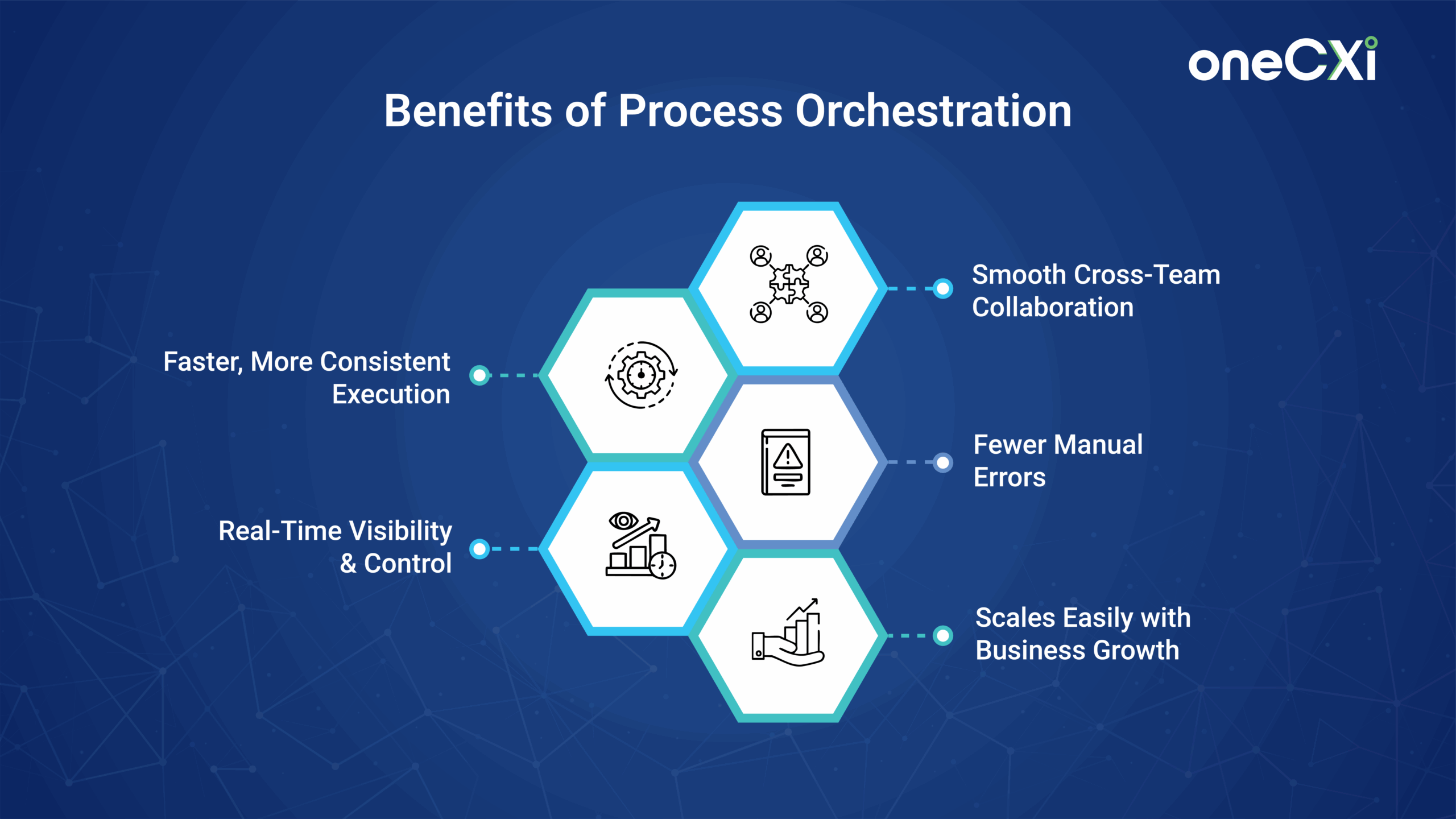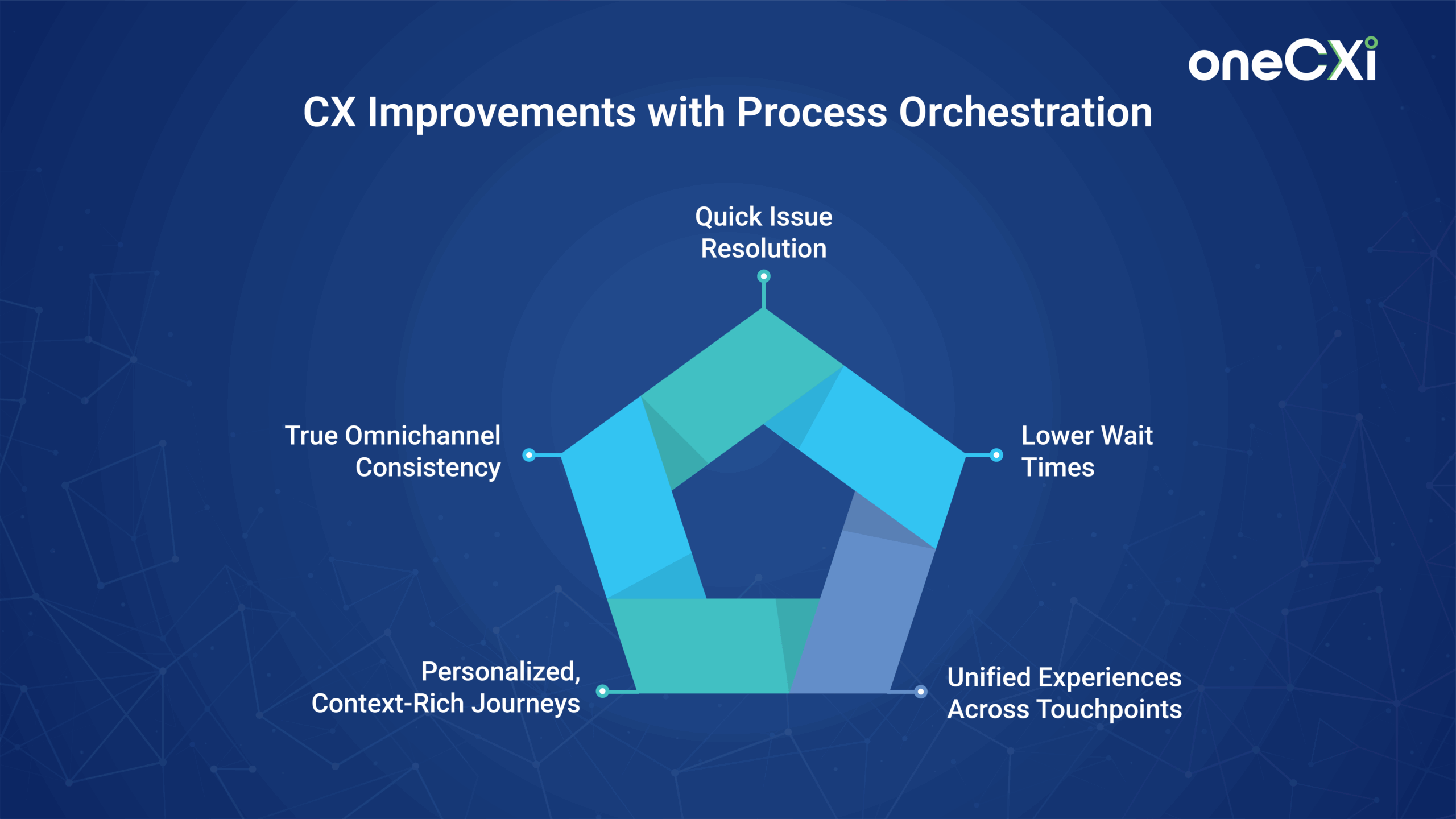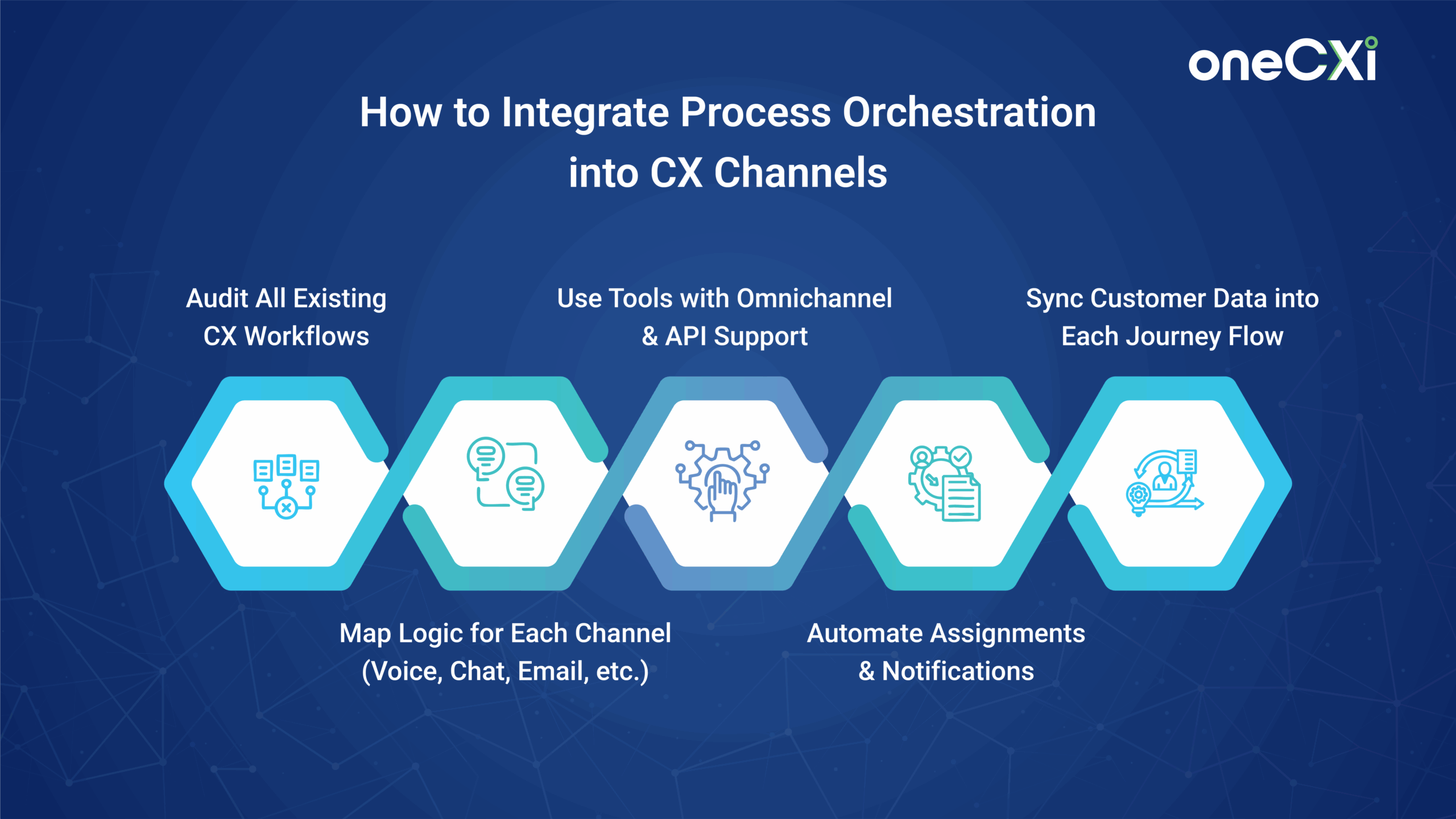- Resources
- How Process Orchestration Improves Customer Experiences
How Process Orchestration Improves Customer Experiences

It only takes one poorly handled interaction for customers to lose trust. You might have a helpful team and a well-meaning support agent, but if they don’t have the right context—or if the customer has to repeat information—the experience falls apart.
This is often due to weak handoffs between teams, outdated systems, or manual coordination. Process orchestration fixes that by syncing systems, setting up rules for handoffs, and keeping customer data consistent across channels.
In this blog, we’ll walk through how orchestration improves customer experience by aligning backend workflows with customer-facing moments. Read along!
In this article, we will explore:
- 1.What is Process Orchestration?
- 2.Components of Process Orchestration
- 3.Importance of Process Orchestration
- 4.Difference Between Process Automation and Process Orchestration
- 5.Benefits of Process Orchestration
- 6.How Process Orchestration Improves Customer Experience
- 7.How to Integrate Process Orchestration in CX Channels
- 8.Real World Use Case
- 9.KPIs Improved With the Implementation of Process Orchestration
- 10.Ready to Fix the Gaps in Your CX?
What is Employee Experience?
Employee Experience (EX) is the overall perception employees have of their journey within an organization. It encompasses every interaction and touchpoint, from recruitment and onboarding to daily responsibilities, support systems, and eventual offboarding.
What is Process Orchestration?
Process orchestration is the method of coordinating and managing multiple automated workflows across systems, teams, and tools in a structured and logical sequence. It connects separate tasks into a unified process that runs smoothly across departments, without manual intervention at each step.
Instead of handling each task or system individually, process orchestration lets you define how different actions, systems, and decisions should interact and in what order. It ensures that every part of a process happens at the right time, with the right input, and follows the correct flow—no missed steps, no duplicate work, and no siloed handoffs.
For example, in a customer onboarding process, process orchestration can automatically link form submissions to identity verification, account creation, welcome email dispatch, and internal alerts, all handled across different systems, without manual coordination.
Components of Process Orchestration
Process orchestration works when several critical components come together to manage workflows, align systems, and automate decision-making across the board. These components are not optional—they define how well your orchestration strategy runs. Below is a detailed look at each one and why it matters in real-world execution.
1. Workflow Automation
Workflow automation is the foundation of process orchestration. It involves setting up sequences of tasks that run without manual input, based on logic and triggers.
- What it does: Automates repetitive or rule-based tasks across departments, like sending approval requests, updating records, or assigning tickets.
- Why it matters: Without workflow automation, you’re just managing disconnected steps. This component builds consistency and removes delays caused by manual follow-ups.
- What to focus on: Choose automation tools that allow you to define if-then rules, decision paths, time-based actions, and escalation logic. Also, make sure they handle both system-based tasks and human-in-the-loop steps.
2. System Integration
Process orchestration depends on how well your systems talk to each other. System integration connects your tools, platforms, and databases so that workflows run across them without stopping for manual transfers.
- What it does: Enables seamless data exchange and task triggering between tools like CRM (customer relationship management), ERP (enterprise resource planning), HR software, and ticketing systems.
- Why it matters: When systems don’t sync, information gets lost, duplicated, or delayed. Integration lets you avoid back-and-forth between teams and reduces the risk of human error.
- What to focus on: Look for platforms with APIs (application programming interfaces) or pre-built connectors. Prioritize two-way integrations that allow both pushing and pulling data between systems.
3. Data Flow Management
Process orchestration isn’t just about task completion—it’s also about data movement. Data flow management controls how information moves across steps and systems.
- What it does: Handles how data is passed, validated, formatted, and stored between processes. Ensures that everyone works from accurate and current data at each stage.
- Why it matters: Poor data flow can break workflows. For example, if customer details aren’t passed from a web form to your CRM properly, follow-ups may fail or reach the wrong contact.
- What to focus on: Build data mapping rules to define what data goes where and in what format. Set up checks for duplicates, missing values, and inconsistencies.
4. Resource Allocation
Resource allocation controls how people, systems, and time are assigned to different steps in a process.
- What it does: Distributes work to the right team members or systems based on workload, availability, skill set, and priority.
- Why it matters: Orchestration fails when tasks pile up on the wrong teams or when automated steps are stalled due to a lack of ownership.
- What to focus on: Set clear assignment logic. For example, route incoming support tickets to agents based on language, product knowledge, or queue size. Track how resources are used and adjust allocations based on performance.
5. Monitoring and Exception Handling
No process runs perfectly all the time. Monitoring and exception handling are key for catching failures, delays, or unexpected conditions in real time.
- What it does: It tracks each step of a workflow, flags delays or errors, and triggers fallbacks or alerts so issues aren’t overlooked.
- Why it matters: If you’re not actively monitoring, process failures will slow things down silently, until they impact your customers or internal teams.
- What to focus on: Set up real-time alerts, audit logs, and dashboards to monitor workflow health. Define fallback rules for when steps are skipped or take too long, such as sending escalations or rolling back a step.
6. Rule-Based Logic and Decision-Making
Every process has points where decisions must be made—like approvals, routing, or content changes. Rule-based logic builds this decision-making into the workflow.
- What it does: Applies business rules to trigger different paths in a workflow. For example, if a request is above a certain budget, it is routed to a senior manager for approval.
- Why it matters: Without logic, processes either stall or rely on inconsistent judgment. Building rules into your orchestration system ensures fast, reliable outcomes.
- What to focus on: Use decision trees, conditions, and variables. Keep rules transparent and editable, so you can adjust them without disrupting the entire process.
7. User Interaction and Approvals
Not every process can run 100% on automation. Some steps need human input, especially for approvals, reviews, or exceptions.
- What it does: Lets users step into workflows at specific points—like reviewing a contract, approving a budget, or entering missing data.
- Why it matters: Orchestration must balance automation with human control. Giving users a clear, timely interface to act keeps processes moving.
- What to focus on: Use role-based access, notification triggers, and simple UIs. Make sure the system pauses the workflow until the user action is complete, then picks it up right after.
Importance of Process Orchestration
Delivering a consistent customer experience is difficult when internal operations are fragmented. Teams often rely on disconnected tools, manual coordination, and unclear handoffs. As a result, even simple customer requests can take longer than expected or slip through the cracks.
Process orchestration helps fix this by connecting workflows across systems and teams. Here are some of the most common CX challenges that highlight the need for process orchestration and how orchestration helps solve them:
Siloed Operations
Most CX issues begin with internal silos. Sales, support, operations, and product teams often use different tools that don’t speak to each other. As a result, critical information stays trapped in one system and doesn’t reach the people who need it. This also means:
- Customers end up repeating themselves because previous interactions aren’t visible across teams.
- Agents can’t see the full history of a customer’s journey, which slows down resolution.
- Back-office teams may not know when to act on a request because they’re not notified in time.
How orchestration helps: Process orchestration breaks these silos by syncing systems and workflows. It lets you route tasks, pass data, and trigger next steps automatically, so everyone works from the same source of truth. No more waiting on someone to forward an email or escalate a ticket.
Delays
Delays often happen because there’s no central coordination. One task waits for another to be completed, but no one is tracking the full process. Even if the initial response to a customer is fast, the follow-through can get stuck in handoffs or bottlenecks.
For example,
- A request may sit idle because the assigned team isn’t notified in time.
- Escalations take longer because approvals aren’t routed correctly.
- Customers wait for updates because status changes aren’t shared across systems.
How orchestration helps: Orchestration defines the exact order of steps in a process and tracks their progress. It automatically pushes tasks forward when conditions are met, without relying on someone to check or remind others manually. This reduces delays across all touchpoints.
Manual Handoffs
Manual handoffs create room for missed steps, errors, and slowdowns. Without automation, employees must manually trigger the next action, update the system, or inform another team. This not only takes time but also leads to inconsistencies, such as:
- Agents might forget to update a case after a call.
- One team may complete their part but fail to notify the next team.
- Tasks fall through the cracks when someone is out of the office.
How orchestration helps: With orchestration, handoffs are automated. When one step finishes, the system triggers the next without needing manual input. If human input is needed, it prompts the right person immediately and tracks response time, keeping the process on track.
Inconsistent Communication
When different teams manage customer touchpoints without coordination, messaging becomes inconsistent. One team may offer something the other team isn’t aware of, meaning that customers get mixed signals and lose trust. For example:
- Support might promise a refund, but billing isn’t informed.
- Sales may upsell a service that’s not yet available, leading to support complaints.
- Updates or notifications might go out late, or not at all.
How orchestration helps: Process orchestration aligns all communication steps and ties them to workflows. It ensures that the right updates go to the right people—internally and externally—at the right time. Every step is tracked, and nothing moves forward until the required action is completed.
Difference Between Process Automation and Process Orchestration
Many teams confuse process automation with process orchestration, often using the terms interchangeably. But these are not the same. Both deal with improving workflows, but they operate at very different levels.| Aspect | Process Automation | Process Orchestration |
|---|---|---|
| Focus | Automates individual tasks | Coordinates end-to-end workflows across teams and tools |
| Scope | Narrow – one task or activity at a time | Broad – spans multiple steps, systems, and teams |
| Goal | Improve efficiency of repetitive manual work | Ensure flow, consistency, and accountability across processes |
| Examples | Auto-send email alerts, generate invoices, fill forms | Manage a full onboarding journey or support workflow from start to resolution |
| Dependency Handling | Does not manage dependencies between tasks | Handles task sequencing, branching, and conditional logic |
| Visibility | Limited – task-level only | Full – provides real-time monitoring of entire process performance |
| When to Use | For simple, repetitive actions within a department | When you need to connect systems, scale workflows, and ensure compliance |
Benefits of Process Orchestration

Process orchestration goes beyond automating tasks—it connects your systems, teams, and workflows in a way that makes operations easier to manage and scale. When done right, it reduces delays, removes manual work, and creates a structure where everything flows as intended.
Let’s discuss these benefits in detail:
1. Faster and Consistent Execution
Orchestration eliminates unnecessary handoffs, delays, and back-and-forth by automating how tasks move from one step to the next.
Instead of waiting for someone to push a request or assign a task manually, the system handles it based on logic you define. This creates a consistent pace across your workflows—tickets get resolved faster, follow-ups happen on time, and you avoid long idle gaps between tasks.
2. Better Visibility and Control
With process orchestration, you get a clear, end-to-end view of how a workflow is progressing.
You can monitor where things are getting stuck, how long each step takes, and who is responsible at each point. This visibility helps managers spot inefficiencies early, adjust workloads, and stay ahead of potential service issues.
3. Seamless Cross-Team Coordination
Processes involving more than one team often fail due to a lack of communication or unclear handoffs. Orchestration solves this by defining exactly how data and tasks move between departments.
It keeps all stakeholders aligned by triggering handoffs, passing data, and prompting actions across teams in real time, without anyone having to send manual updates or reminders.
4. Fewer Manual Errors
Manual steps lead to mistakes—wrong data entries, missed approvals, or delayed updates.
Orchestration removes most of this risk by automating repetitive tasks and routing decisions based on clear rules. It also standardizes processes, so everyone follows the same structure instead of improvising their way through tasks.
5. Easier Scalability
As your business grows, processes become more complex. Without orchestration, managing that growth is difficult because each new product, team, or service adds more manual steps and dependencies.
Orchestration helps you scale by letting you build, edit, and connect workflows across systems, without having to redesign your operations every time something changes.
How Process Orchestration Improves Customer Experience

Customer experience (CX) often breaks down not because of bad service but because of disconnected systems, unclear ownership, and slow internal processes. Process orchestration directly addresses this by structuring how tasks move across teams and platforms.
Here are some ways that process orchestration improves customer experience:
Faster Issue Resolution
When a customer submits a query or complaint, it often passes through multiple departments—support, billing, tech, or operations. Without orchestration, this movement is slow, manual, and error-prone.
Process orchestration fixes that by routing tickets, tasks, and data instantly to the right team based on rules you define. It also automates follow-ups, sets escalations, and tracks progress in real time.
This reduces resolution time, shortens backlogs, and ensures that no request falls through the cracks. Customers benefit from fewer delays and faster responses.
Seamless Omnichannel Experience
Customers expect to interact with your brand across multiple channels—web, phone, email, chat, or apps—and still receive consistent service. The problem is, many businesses run these channels in silos.
Process orchestration connects these channels behind the scenes. It tracks customer activity across all touchpoints and carries context from one channel to the next.
This allows agents to pick up conversations where they left off, no matter how or where the customer reaches out. It also lets workflows continue uninterrupted, even as the interaction moves from one channel to another.
Personalized Customer Journey
Without orchestration, digital customer journeys feel generic. You send the same messages, take the same actions, and miss context that could make the experience more relevant.
Customer journey orchestration brings structure and logic to personalization. It allows you to insert customer data—like purchase history, service preferences, or past interactions—into workflows and act on that data in real time.
For example, if a customer has an open service request, the system can automatically suppress irrelevant marketing messages or flag their case for higher priority handling. This makes each interaction feel more tailored and timely.
Reduced Average Wait Times
Average wait times go up when processes are blocked. That happens when tasks need approvals, dependencies aren’t clear, or different teams don’t know what’s pending on their side.
Orchestration reduces this by automatically managing task handoffs and timing. It prompts the right people, escalates when delays occur, and updates all systems at once so the next step isn’t left waiting.
Customers don’t have to chase updates or sit through long queues, because the process keeps moving without unnecessary delays.
Customers don’t care how many systems your teams use. But they notice when your systems don’t talk to each other. If your CRM, helpdesk, and billing tools are disconnected, customers are likely to face repetitive questions or inconsistent service.
Process orchestration integrates these systems into one continuous flow. It makes sure customer data, status updates, and task outcomes move between tools automatically. This creates a unified view for your teams and a consistent experience for your customers, regardless of which channel or system is involved.
How to Integrate Process Orchestration in CX Channels

Here’s a step-by-step approach to help you integrate process orchestration into your CX channels effectively:
1. Audit Existing CX Workflows Across All Channels
Start by mapping how customer requests move across your current CX channels. Look at:
- What happens when a customer submits a request on chat, email, or voice?
- How are follow-ups handled?
- Where do delays or manual tasks occur?
- Which tools are involved in each step?
2. Define Clear Workflow Logic for Each Channel
Every CX channel has different interaction patterns. Build orchestration logic that fits each one:
- Chat: Automate initial triage, categorize queries, and route based on keywords or sentiment.
- Voice: Use IVR with rule-based routing, then trigger workflows based on call inputs or CRM data.
- Email: Automatically read and tag incoming emails, then assign tickets or trigger workflows based on templates or priority.
- Self-service: Set workflows that auto-create support tickets, send confirmations, or escalate when users reach a certain threshold (e.g., failed attempts or drop-off points).
3. Choose Tools That Support Omnichannel Integration
Select orchestration platforms that connect with your CRM, ticketing tools, contact center platforms, and communication channels. Look for:
- Pre-built connectors for chat, telephony, email, and social tools
- Support for both real-time and rule-based workflows
- Compatibility with your existing automation setup (RPA, BPM, or iPaaS)
4. Automate Task Assignments and Internal Notifications
Use orchestration to automate internal handoffs based on defined rules. For example:
- A high-value customer’s email complaint gets routed directly to a senior support agent.
- A chat-based billing query triggers a call-back request to the finance team.
- A failed IVR journey sends an alert to a manager and opens a ticket automatically.
5. Integrate Customer Data into the Orchestration Flow
Personalization depends on real-time access to customer data. Orchestrated CX workflows should:
- Pull CRM data like customer type, purchase history, and open cases
- Use this data to route, prioritize, and personalize interactions
- Feed updated data back into the system after each step (e.g., ticket closed, SLA met)
This makes sure every team working with the customer has full context, improving accuracy and consistency.
Real World Use Case
Let’s say you run a mid-sized telecom company that offers broadband, mobile, and digital TV services. Your support team handles queries via phone, live chat, WhatsApp, and email.
Without orchestration, your agents constantly switch between tools, escalate issues manually, and lose track of follow-ups. Customers often repeat their concerns multiple times or wait hours for a simple update.
Now, here’s how process orchestration changes that.
- A customer raises a complaint via WhatsApp about a billing discrepancy. The system automatically pulls up their details from your CRM, tags the query based on keywords, and routes it to the billing support team.
- Since this customer is a premium subscriber, the query is flagged for faster handling.
- If the issue isn’t resolved within 30 minutes, the system auto-escalates it to a supervisor.
- If the customer switches to voice support mid-conversation, the agent who picks up the call already has full context—there is no need to repeat anything.
- Once resolved, a CSAT survey is sent automatically through their preferred channel. Meanwhile, the workflow also logs the resolution in your backend and updates the billing system to prevent similar issues for other users.
This kind of end-to-end coordination is what builds customer loyalty and trust across your entire support experience.
KPIs Improved With the Implementation of Process Orchestration
Process orchestration helps you fix the root causes of delays, inconsistencies, and inefficiencies that directly impact customer satisfaction and service quality. As a result, key performance indicators (KPIs) tied to CX begin to shift in the right direction.
Here are the specific KPIs that process orchestration helps improve—and how:
NPS
NPS measures how likely your customers are to recommend your brand to others. A low NPS often signals inconsistent service, slow issue handling, or disjointed experiences across touchpoints.
Process orchestration directly improves NPS by bringing predictability and structure into the customer journey. It connects different systems so customers aren’t passed around. It ensures that every step—support, onboarding, billing, delivery—flows without unnecessary friction.
CSAT
CSAT captures how satisfied customers feel after a specific interaction, such as a support call, service request, or product delivery. Poor CSAT scores usually point to a delay in resolution, a lack of context, or repetitive conversations.
Process orchestration helps teams respond quickly and with full context by coordinating tasks and automating handoffs. They act faster, respond accurately, and complete requests without asking customers to repeat details, leading to higher satisfaction at the point of service.
Customer Retention
Customer retention is impacted when customers feel frustrated, unheard, or experience repeated service failures. A smooth product or onboarding experience isn’t enough—ongoing support and communication must also work without gaps.
Process orchestration helps you build consistency across every touchpoint, not just the first few. From follow-up reminders to scheduled renewals and proactive alerts, orchestration keeps the customer loop running without manual triggers.
Response and Resolution Time
Long wait times and slow issue handling are some of the biggest CX complaints. Often, the cause isn’t agent performance—it’s broken internal workflows or dependencies that aren’t tracked properly.
Process orchestration fixes this by setting clear workflows and automating task assignments, escalations, and notifications. It ensures that each step in the resolution process happens without delay and gives agents real-time access to what’s already been done.
Ready to Fix the Gaps in Your CX? Here’s Where Ozonetel Comes In
Delivering a smooth customer experience isn’t just about having the right people—it’s about building the right processes. Process orchestration helps you remove delays, reduce manual work, and connect every step of the customer journey, no matter how complex or cross-functional it gets. But orchestration only works when you have the right platform to support it.
That’s where Ozonetel makes a real impact. Our full-stack CX platform brings automation, intelligent routing, AI agent assist, sentiment detection, and omnichannel support into one place, so your workflows stay connected and your teams stay aligned. From first contact to final resolution, Ozonetel helps you manage every part of the customer journey with context, speed, and consistency.
How Ozonetel’s oneCXi Platform Optimizes the Customer Journey Map
Mapping the customer journey is just the beginning. Real impact happens when you can act on those maps—delivering seamless, intelligent interactions at every step. That’s where Ozonetel’s oneCXi platform transforms mapped journeys into orchestrated, real-time experiences.
Here’s how oneCXi brings your customer journey maps to life:
- Unifies Every Touchpoint Across Channels
Whether it’s voice, chat, WhatsApp, or social, oneCXi ensures all interactions happen on a single, connected platform—so customers can switch channels without breaking their journey. - Reduces Friction with AI-Powered Routing
Contextual, skills-based, and intent-driven routing ensures every query reaches the right agent or self-service flow—eliminating unnecessary hops and speeding up resolution. - Enables Proactive Follow-Ups with Deep CRM Sync
From lead capture to ticket creation, oneCXi integrates directly with your CRM—triggering timely, automated follow-ups that align with each stage of the customer journey. - Empowers Agents with Journey-Aware Context
Before a call or chat begins, agents get real-time visibility into the customer’s history, behavior, and stage—be it onboarding, purchase, renewal, or escalation. - Automates Repetitive Interactions Intelligently
With conversational IVRs, voice bots, and smart nudges, oneCXi automates common customer tasks—freeing up agents to focus on high-impact moments in the journey.
Ozonetel’s oneCXi platform doesn’t just support your journey maps—it activates them, ensuring every touchpoint is intelligent, connected, and outcome-driven.
Conclusion: Why Ozonetel is a Leading Cloud Contact Center Platform
Ozonetel is more than just a cloud contact center—it’s a complete, enterprise-grade CX platform built for speed, intelligence, and scale. It enables businesses to launch quickly, streamline operations, and elevate both customer and agent experiences without the burden of complex setup or third-party dependencies.
What Sets Ozonetel Apart:
- Built-in Telephony: Fully integrated voice stack with zero reliance on third-party vendors
- Fast, No-Hassle Deployment: Go live with minimal IT intervention
- Omnichannel Engagement: Connect seamlessly across voice, chat, WhatsApp, social, email, and more
- Real-Time Visibility: Live dashboards and in-depth analytics for smarter decisions
- AI at the Core: Conversational intelligence, agent assist, auto QA, and smart routing
- Transparent, Scalable Pricing: Grow without worrying about hidden charges
- Remote-Ready Infrastructure: Maintain high agent performance from anywhere
With Ozonetel, businesses get a unified platform that brings together automation, analytics, and agility to orchestrate connected experiences. It helps you capture more value from every interaction—without adding complexity.
If you're looking to make your CX processes faster, smarter, and easier to manage across channels, it's time to explore what Ozonetel can do.
Frequently Asked Questions
Yes, most cloud contact centers follow strong security practices like data encryption, role-based access, and compliance with standards such as GDPR or SOC 2. Also, always confirm what security certifications and measures the provider has in place.
Absolutely. Agents can log in from anywhere using an internet connection. Also, cloud platforms are built for flexibility and support distributed teams without extra setup.
AI helps by automating routine queries, predicting customer needs, suggesting responses, and routing tickets to the right agents. This speeds up resolution, reduces agent workload, and improves accuracy.







